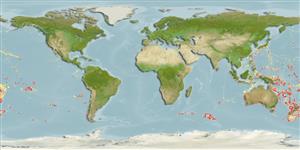Environment: milieu / climate zone / depth range / distribution range
Ökologie
seewasser benthopelagisch; tiefenbereich 580 - 1100 m (Ref. 58302). Deep-water
Western Pacific: in temperate waters; Sagami Bay, Ramapo Bank and Emperor Seamounts (Japan); southeastern Australia, New Zealand north of Clatham Rise and off New Caledonia (Ref. 31777). Central Pacific (Ref. 58302).
Size / Gewicht / Alter
Maturity: Lm ? range ? - ? cm
Max length : 60.5 cm SL Männchen/unbestimmt; (Ref. 31777)
Found on the continental slope (Ref. 7300, 75154). Benthic or benthopelagic (Ref. 58302, 75154). The species is the largest in the family, an exceed 2 m in length (Ref. 31777).
Life cycle and mating behavior
Geschlechtsreife | Fortpflanzung | Ablaichen | Eier | Fecundity | Larven
Paxton, J.R., D.F. Hoese, G.R. Allen and J.E. Hanley, 1989. Pisces. Petromyzontidae to Carangidae. Zoological Catalogue of Australia, Vol. 7. Australian Government Publishing Service, Canberra, 665 p. (Ref. 7300)
IUCN Rote Liste Status (Ref. 130435)
Bedrohung für Menschen
Harmless
Nutzung durch Menschen
Mehr Information
NamenSynonymeMetabolismusRäuberÖkotoxikologieFortpflanzungGeschlechtsreifeAblaichenSpawning aggregationFecundityEierEientwicklung
Alter/Größe
Wachstum
Länge-Gewicht
Länge-Länge
Längenhäufigkeiten
Morphometrie
Morphologie
Larven
Larven Pop.Dyn.
Rekrutierung
Dichte
BRUVS
ReferenzenAquakulturAquakultur ProfilZuchtlinienGenetikElectrophoresesVererbbarkeitKrankheitenVerarbeitungNutrientsMass conversion
PartnerBilderStamps, Coins Misc.LauteCiguateraGeschwindigkeitSchwimmstilKiemenoberflächeOtolithsGehirngrößeSehfähigkeit
Tools
Zusatzinformationen
Download XML
Internet Quellen
Estimates based on models
Preferred temperature (Ref.
123201): 2.3 - 8.4, mean 6.2 °C (based on 322 cells).
Phylogenetic diversity index (Ref.
82804): PD
50 = 0.5020 [Uniqueness, from 0.5 = low to 2.0 = high].
Bayesian length-weight: a=0.01000 (0.00244 - 0.04107), b=3.04 (2.81 - 3.27), in cm total length, based on all LWR estimates for this body shape (Ref.
93245).
Trophic level (Ref.
69278): 3.5 ±0.5 se; based on size and trophs of closest relatives
Widerstandsfähigkeit (Ref.
120179): sehr niedrig, Verdopplung der Population dauert mehr als 14 Jahre. (Preliminary K or Fecundity.).
Fishing Vulnerability (Ref.
59153): Moderate to high vulnerability (50 of 100).
